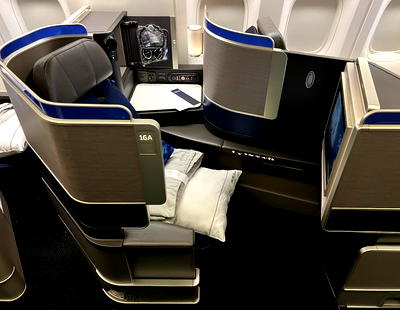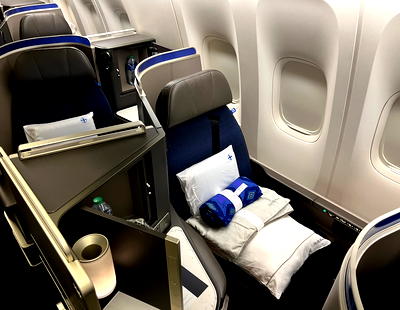This is rare, but not unheard of…
In this post:
Tail-heavy United Boeing 737-900 tips
On Friday, September 17, 2021, United Airlines operated a 1hr52min flight from Los Angeles, California (LAX), to Lewiston, Idaho (LWS). This charter flight was carrying the USC football team, ahead of the USC vs. Washington State game, which happened over the weekend. The flight was operated by a nine-year-old Boeing 737-900ER with the registration code N78448.
The flight operated without a hitch, until it arrived at its destination. At some point during the disembarkation process, the aircraft’s nose wheel lifted off the ground, and the plane “tipped” backward.
In the picture posted on social media, you can see that bags were being offloaded through the forward right cargo door, and on top of that passengers were being disembarked through air stairs via the forward left door.
There were no injuries to those still onboard the plane, and for that matter the plane didn’t seem to sustain any serious damage, as it flew a couple of days later from Lewiston to Houston.
How can planes “tip” like this?
United Airlines has issued the following statement regarding the incident:
“United flight 2509 flying from Los Angeles, California to Lewiston, Idaho landed without incident. Due to a shift in weight and balance during the offloading process, the tail of the aircraft tipped backward. No injuries were reported among our customers, crew or ground personnel. The return flight was on a different aircraft as originally planned.”
As you can see, United Airlines blames this incident on “a shift in weight and balance.” Of course one has to wonder how something like this could happen, since planes fly around the world every day, and rarely do we see something like this.
There are probably a few things at play here. For one, over time aircraft manufacturers “stretch” planes, and the 737-900 is currently the longest version of the 737 in service. As a result, the plane is also the most prone to something like this happening.
As you might expect, there’s a solution to this. Typically when airlines operate the 737-900, they use a “tail stand” while disembarking passengers. The purpose of the tail stand is to prevent exactly what happened here. The catch is that these devices are generally available at airports, and it’s not a device that’s carried with the plane.
Lewiston is an airport that typically only serves regional jets, so it seems safe to assume that the airport didn’t have any 737 tail stands.
Even without tail stands, it’s not like the plane is actually supposed to “tip” in this way. Clearly the pilots and ground crew didn’t anticipate this, or they would have taken action to prevent it.
While with normal procedures the plane wouldn’t tip, just enough went wrong that it became an issue:
- Luggage is seemingly being removed through the forward cargo door, so maybe a lot of weight had already been removed there
- Passengers disembark front to back, so perhaps passengers weren’t moving forward that quickly, and for that matter maybe the average passenger weight in the back of the plane was higher than usual; it is stated that the players were seated in the front and support staff and coaches were seated in the back, but I’d still think they’d weigh more than your average airline passengers (since there are fewer children, women, etc.)
Without a tail stand, deplaning and unloading a 737-900 sure is a delicate balancing act…
Bottom line
A United Boeing 737-900 tipped on its tail while deplaning passengers after a charter flight from Los Angeles to Lewiston. Ultimately this could have been prevented by using a tail stand, but it’s not surprising one of those wasn’t available at an airport that typically only gets service from regional jets.
Even without a tail stand, these incidents shouldn’t happen. I guess there was just the perfect storm of not enough weight in the front of the plane (in terms of passengers and bags/cargo), and too much weight in the back of the plane.
No one was injured, and it seems the plane wasn’t damaged significantly, so we’re just left with a pretty cool story, and a heck of a picture.
What do you make of this United “tipping” incident?





The center of gravity of the plane is too near the back wheels. It should be more forward.
Teamsters signing off on shoddy repair work as part of Gavin Newsom’s bribery scheme with United.
Avoid United, especially in SFO and LAX, especially if the plane has been serviced in CA.
I was on a 737-800 and upon landing we were asked to disembark back to front.
No explanation was provided, but it may have been due to a risk of tipping.
I guess it worked, we disembarked as requested and without incident.
The crew in this case could have done the same.
would think that now this is a favorite plane amongst the xtreme travelers - Wouldn't you like to fly on a plane that "popped" a wheelie :-)
I am amazed that such a flimsy-looking tail stand pole can keep the plane from tipping. How many tons of pressure are centered on the few-square-inch diameter device?
Comments on A.net indicate the passengers in the rear stayed in their seats because they were waiting for a late to arrive bus to transport them to their hotel. Meanwhile the passengers in the front of the aircraft disembarked and the front bin was unloaded.
Former ramp rat. We were trained at my US carrier to always offload the aft cargo first on most aircraft, as their inherent center of gravity without balance was just behind the landing gear, and a tip would be possible if aft cargo was not unloaded, forward cargo was unloaded, and enough passengers disembarked. We never used tail stands for such aircraft, we just unloaded according to that procedure. The exception was on the E-jets,...
Former ramp rat. We were trained at my US carrier to always offload the aft cargo first on most aircraft, as their inherent center of gravity without balance was just behind the landing gear, and a tip would be possible if aft cargo was not unloaded, forward cargo was unloaded, and enough passengers disembarked. We never used tail stands for such aircraft, we just unloaded according to that procedure. The exception was on the E-jets, where almost all baggage went in the forward cargo, negating this issue. I only saw one aircraft at risk of a tip, and that was because the team was messing around with a pushback tractor instead of offloading as the passengers were disembarking. The nose shock absorber was extended further than I’d ever seen it, and we knew the jet bridge was likely holding traction, but would only do so for so long. We ran over and helped them offload before that happened. We never used a tail stand, and I’ve never seen one used regularly. I’ve heard of stands used on the 727 and the IL-62, but I never saw one during my time on the ramp…
Boeing has stretched the 737 way beyond what it’s supposed to do. This is now a flawed design and all the 737s are inferior to their Airbus competitors.
Eskimo, come on man, are you in Boeing PR? It was a software patch to deal with the fact that they pushed it too far with the position of the engines while not making airlines re-train pilots. It was a purposeful design flaw, that I’ll agree with, aimed at their stock price. Obviously all aircraft manufacturers push it on certain things but this one was egregious and it cost them 3 planes. Is it the same as a stand on the tail? Uh, no.
@BradleyEC
Well then we should be flying in helium balloons like the animation "UP".
Having an object heavier than air and make it float in the air should be purposeful design flaw no?
It's physics.
You strap a NASA rocket on a 737 to make it go Mach 8 it disintegrates.
You strap the same rocket on a Lunar Lander inside a command module and it goes to the moon.
Is...
@BradleyEC
Well then we should be flying in helium balloons like the animation "UP".
Having an object heavier than air and make it float in the air should be purposeful design flaw no?
It's physics.
You strap a NASA rocket on a 737 to make it go Mach 8 it disintegrates.
You strap the same rocket on a Lunar Lander inside a command module and it goes to the moon.
Is the Saturn V a design flaw? Neil Armstrong doesn't think so.
You probably heard the story about a the hot coffee lawsuit.
So if the Caution: Contents Hot warning is a bit too small, it's a design flaw? We're still using the same cup today with or without the warnings.
Or any consumer product is a design flaw in the eyes of California?
Every damm thing has a Prop65 warning.
And don't get me wrong, if you have been following me, I did trash Boeing several times even about MCAS. But like my other examples, the MCAS is just not a design flaw, it's designed that way.
As a ramp worker here in Sydney Australia, we're also taught to unload the rear cargo hold first prior to the front cargo hold for weight and balance purposes and to avoid tipping incidences. Who knows how the ramp staff offloaded the aircraft but also we don't use those tail stands here in Sydney, just always offload the rear first and there shouldn't be any issues.
I’m reading this while sitting on a United 737-900. I’m not a pilot but I’m reasonably observant and I don’t recall seeing these tail stands used. Considering the envelope Boeing pushed with the MAX, this rather primitive device to deal with a design flaw seems disquieting.
In any event, when I get to O’Hare later where I assume United will have a number of -900s on hand I’ll be looking for any of these tail stands in use.
Just like the MAX, it is not a design flaw.
People have to understand that it was designed that way. MAX had a software flaw not a design flaw. And plane that have bad weight distribution will tip, again not a design flaw but it's designed that way, even the beloved 747s can tip.
If you still think it is a design flaw, than anything heavier than air and flying is a design flaw.
And lucky this isn't the MAX otherwise people would still blame it on MCAS.
All Alaska planes at SeaTac have these tail stands.
I'm a very big guy. Maybe I should tell airlines that I always need an upgrade to a seat ahead of the wheels (like business class) to make sure that the plane doesn't tip.
Hah, but be prepared to wait till the end before they let you get off :).
@smallmj, that's very thoughtful of you. Thanks for your sacrifice.